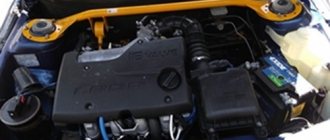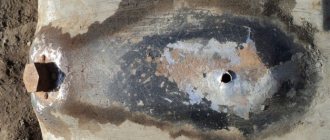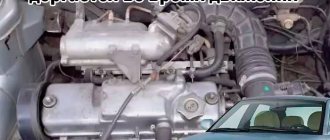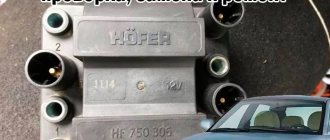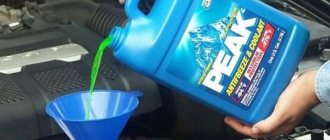The topic of this article is the VAZ-2110 engine (8 valves) injector in the fuel injection system. The main task is to find all its advantages and disadvantages and compare it with a carburetor engine. But to do this, you will need to delve a little deeper into history, look at how this engine was developed, how good it is in operation and repair. And the story will begin in the late 70s of the last century, when VAZ engineers started thinking about designing front-wheel drive cars. And then we will look at the injection system, its differences from the carburetor, its advantages and disadvantages.
Engine history
And now the story about where the VAZ-2110 engine (8 valves) injector comes from. And it was put in place at the end of the 70s. During these years, designers begin to understand that the classics produced for many years have a high cost. In addition, the Fiat 124 was the best car in Europe in 1964. Almost two decades have passed, the model range needs to be updated. And the experiments began. First of all, we modernized the gas distribution drive and started using a belt. But it did not take root on the VAZ-2105 engine (production years: 1980-1988), although it reduced the noise level.
The reason is simple: the pistons need scrapings that prevent them from hitting the valves if they break. But when repairing engines, pistons with 1.3 liter engines were installed, as a rule, of suitable size, but without recesses. But in the early 80s the eighth generation was released. Newer, comparable to European counterparts. And most importantly, the cars have front-wheel drive, a motor with a belt drive to a timing mechanism. And this was the same engine that, with a lot of modifications, is installed on modern cars. On models 2109 and 2110, these power units were adapted for the first time to an injection system.
2.0 liters, injector
It was not at all necessary to perform complex engine tuning or organize chip tuning in order to increase the power and characteristics of the engine. This is because AvtoVAZ released a limited edition of the VAZ 2110 model, under the hood of which there was an interesting, unusual engine.
Under the hood of the limited ten there was an engine manufactured by Opel. Its power is 150 horsepower.
Engine from Opel
In addition to this German power unit, development of a rotary piston engine was carried out.
Alas, both engines, for unknown reasons, never received the popularity they deserved. Although, given the external data of the “ten”, its technical capabilities, the presence of 150 horses under the hood today would please a huge number of young drivers who cannot afford to buy an expensive car.
Main engine components
No significant differences may be detected upon a cursory examination. Both carburetor and injection systems do not affect the basic design of the engine. But it's worth taking a closer look at the little things. For example, take a look at the VAZ-2110 injector thermostat (8 valves). What immediately catches your eye is that it can be taken apart! Exactly! Engineers in Europe sit and think about how to reduce the life of a car, while ours at the same time carry out real improvements that are for the benefit of the consumer. It is clear that it is not the housing that breaks in the thermostat, but the insides - the temperature-sensitive element or valve. Therefore, why produce millions of cases? It will be much more profitable to make one for the car, and if the thermostat breaks down, change only the insides.
But these are not all the advantages of domestic engines. Please note that in the USA and Europe all cars are the same, sometimes there is no point in repairing it, it’s easier to throw it away and buy a new one. The reason is partly in the engine. For example, AvtoVAZ is almost the only plant that continues to install internal combustion engine blocks made of cast iron on its products! In all developed countries, aluminum alloys have long been used for this purpose! The service life of the engines suffers, but most importantly, there is no way to repair it, since it cannot be bored or relined. And this is much cheaper than buying a new engine or car. Maybe a wealthy burgher can afford this, but in our country a car is still a luxury for many people.
Pros and cons
The above description of the parameters exceeds the characteristics of the entire line of internal combustion engines existing at that time, produced by AvtoVAZ. However, “inherited” from the 21083 and 2110 engines, the 2111 engine received disadvantages:
- breakage of studs in the muffler-exhaust manifold mounting;
- breakdown of the fuel submersible pump;
- leaking valve cover gasket;
- low resource of cooling system elements;
- periodic adjustment of valves.
The advantages are low oil and fuel consumption, possible boosting with your own hands, but only by modifying existing units.
What is an injector?
Now let’s see what the injector circuit looks like on a VAZ-2110 car, let’s look at the main components and operating principle. But first you need to answer the questions of what an injector is and what it is needed for. Everyone knows that until the end of the 90s carburetors were installed. In them, with the help of air flows, mixture formation took place, and then supply to the intake manifold of the fuel system. Moreover, such a cunning device can mix gasoline with air in an ideal proportion - 14 to 1. But there is a game of vacuum and atmospheric pressure.
Injector features
But the VAZ-2110 engine (8 valves) injector is much simpler than the carburetor version. But this is from the point of view of an electrician. The fact is that the system consists of many electronic devices that are responsible for the operation of the entire engine. Instead of a carburetor, a ramp is installed on the intake manifold. Essentially, this is a piece of pipe that contains the air-fuel mixture. It is pumped from the tank using an electric pump under low pressure. By default, the ramp is completely sealed; it is separated from the intake manifold channels by electromagnetic valves - injectors. But here’s the peculiarity: a constant pressure is maintained in the ramp, which is regulated by a sensor, and the quality of the mixture and the amount of gasoline supplied depend directly on how open the throttle valve is.
Which engine is better, 1.6 16- or 8-valve?
16 classes the engines were installed in a limited series at AvtoVAZ or at the SuperAvto subsidiary. They were also installed by tuning fans themselves.
In terms of manufacturability, they are superior to 8-cl. engines. Accordingly, if there is an option to take a 16-cl. motor, it would be nice to go with this option. But everything has its own nuances.
Advantages of 16-valve engines over 8-valve engines
- The best cylinder blowing is more power.
- More stable engine operation - less noise.
- Greater efficiency means lower fuel consumption.
However, 16th grade. the engine (1.6 l) from Priora (21126) bends the valves when the belt breaks. For some reason this scares many people. You just need to monitor the condition of the car, belts, rollers, pump, then everything will be fine! On all modern cars the valves bend.
Diagram of the injection system
So, now in more detail about the power supply systems of the VAZ-2110 injection engine. First on the list is the fuel pump. It is mounted directly in the tank, together with the filter, and the engine rotor is driven only when the ignition is turned on (provided that the pressure in the ramp is below the minimum level). Next, the fuel flows through the tubes into the ramp. This is where the mixture is formed. The air first passes through a filter for purification. The filter housing is connected to the throttle assembly by a flexible pipe.
Sensor system
The VAZ-2110 engine (8 valves) is no less interesting. The injector, a control system device, to be more precise, includes many sensors. All control occurs using sensors. So, between the filter and the throttle there is a mass air flow sensor. A position sensor is mounted on the damper itself. In the ramp - pressure. In addition, between the second and third cylinders on the surface of the internal combustion engine block there is a knock sensor. And on the generator drive pulley - engine speed. The vehicle's speed is measured from the gearbox. All data that comes from reading devices is sent to the electronic control unit.
What cars was it used in?
The 2111 engine was installed on the following models of front-wheel drive VAZ cars:
- 2108 – three-door hatchback;
- 21083 – three-door hatchback;
- 2109 – five-door hatchback;
- 21093 – five-door hatchback;
- 21099 – sedan;
- 2113 – three-door hatchback;
- 2114 – five-door hatchback;
- 2115 – sedan;
- 2110 – sedan;
- 2111 – five-door station wagon;
- 2112 – five-door hatchback.
The engine was installed on the “eights” and “nines” after 1987, respectively.
And in conclusion, I would like to say about tuning the VAZ 2110 engine.
In the VAZ 2110, engine tuning is very easy to do. To do this, you only need a tool and a room. This process can be done not only in a specialized workshop, but also in your garage.
Tuning a VAZ 2110 engine requires only a set of tools and patience:
- The first step is to simply replace the camshaft with a better one. Due to this, power will increase and engine performance will improve.
- You can also install a new crankshaft to increase the volume of the unit. If this is not done, then further tuning of the VAZ 2110 engine will be in vain.
- The installation of a compressor is quite simple. This unit allows you to increase power and get good torque.
- It is worth noting that tuning the VAZ 2110 engine can be done by anyone. This does not require special experience or skills. It is enough to know the structure of the car and have locksmith skills. Experts recommend installing a high-quality stock piston so that it can withstand about 0.5 bar.
Electronic control unit
This is, so to speak, the very heart of the system. On the VAZ-2110, the injector circuit comes down to precisely this device. A small case with many pins, and inside is the most interesting thing - a microcontroller. It is he who regulates the entire operation of the engine. The internal memory contains a so-called fuel map. Using it, the controller determines how much air and gasoline must be supplied to the ramp so that the engine operates in normal mode and detonation does not occur. But the most important thing is how long it is necessary to apply an impulse to the fuel injectors so that they open and inject the mixture into the combustion chamber.
Which is better: carburetor or injector?
And now a little about which VAZ-2110 engine will be more reliable: an injector or a carburetor? But you need to look at this issue from different angles. For example, beginners will like the injector. Constant speed, there is no need to shut off the air supply in cold weather, and starting off is much easier. But there is another advantage - the car is more responsive at high speeds. Even at a speed of 120 km/h, when you press the gas pedal, the car quickly picks up speed. With carburetor engines this happens much more slowly. Therefore, overtaking in a car with an injector is safer. But when starting from a traffic light, the carburetor will easily “break” the injector. And the reason is higher torque at the bottom. And the cost of maintenance, of course, is higher for injection “tens”, since sometimes it is not easy to make an accurate diagnosis in the event of a breakdown.
Typical faults
After many years of operating experience, it was noticed that the 2111 engine is susceptible to the following breakdowns:
| Malfunction | Cause | Elimination |
| ICE “troits”, speed fluctuates | 1) damage to the TPS sensor |
3) gasket breakdown
2) installation of a new valve
3) replacing the gasket
2) wear of connecting rod bearings or main bearings
3) the service life of the rings and pistons is exhausted
2) thermostat failure
The exhaust system of the engine is not fully developed, so the exhaust manifold cracks and its fasteners break. A special feature of the timing belt is the low life of the valve cover gasket.
VAZ 2110 injector engine, diagram and principles of operation of the “tens” injection engine
The VAZ 2110 is an injector engine that is distinguished by its efficiency, increased power and stability of operation when compared with the VAZ 2110 carburetor engines. The widespread use of injection engines at AvtoVAZ began in the 2000s. Today we will tell you in detail how the “ten” injection engine works. It is worth recalling that the “ten” injection engines were installed with different volumes and number of valves. Today on the secondary market you can find injection VAZ 2110 with 8 and 16-valve power units with a displacement of both 1.5 and 1.6 liters.
VAZ 2110 engine injector, operation diagram
Power units with an injector differ from carburetor versions in the principle of supplying fuel to the combustion chamber of a gasoline engine. If a carburetor engine needs to “suck” fuel from the carburetor chambers, then in the injection version fuel is injected under pressure through nozzles. This is much more economical, since the solenoid valves of the injectors allow only the required amount of fuel to pass through and not a drop more. This is closely monitored by electronics, which gives commands using information from various sensors; after analyzing all the data, the necessary impulse is sent to the injector and it supplies fuel to the engine. Moreover, the entire process occurs almost instantly. Below is a detailed diagram of the operation of the VAZ 2110 engine injector.
- 1 – ignition relay
- 2 – battery
- 3 – ignition switch
- 4 – neutralizer
- 5 – oxygen concentration sensor
- 6 – nozzle
- 7 – fuel rail
- 8 – fuel pressure regulator
- 9 – idle speed regulator
- 10 – air filter
- 11 – diagnostic block
- 12 – mass air flow sensor
- 13 – tachometer
- 14 – throttle position sensor
- 15 – indicator lamp “CHECK ENGINE”
- 16 – throttle assembly
- 17 – immobilizer control unit
- 18 – ignition module
- 19 – coolant temperature sensor
- 20 – controller
- 21 – spark plug
- 22 – knock sensor
- 23 – fuel filter
- 24 – fan switch relay
- 25 – electric fan of the cooling system
- 26 – relay for turning on the electric fuel pump
- 27 – fuel tank
- 28 – electric fuel pump with fuel level indicator sensor
- 29 – gasoline vapor separator
- 30 – gravity valve
- 31 – safety valve
- 32 – speed sensor
- 33 – crankshaft position sensor
- 34 – two-way valve
The most important element of the power system of the “ten” injection engine is the electric fuel pump, which is located in the tank; it is this that constantly provides the necessary pressure in the ramp with injectors through which fuel is supplied to the intake manifolds. The fuel pump in the VAZ 2110 injector is quite noisy. It is enough to insert the ignition key and turn it, and you will hear the characteristic “buzzing” of the electric fuel pump inside the car. If you do not hear a buzzing sound before starting the engine, but the engine still does not start, then the fuel pump is faulty. And therefore, it will not be possible to start an injection engine from the “pusher”, because there is still no pressure in the ramp and injectors, which means that fuel will not be supplied.
Repair and maintenance of injection engines requires special diagnostic equipment. The VAZ 2110 was equipped mainly with injection engines with a displacement of 1.5 and 1.6 liters, both 8 and 16 valve versions. Below are brief characteristics of these motors in the table below.
Engine model
| Working volume | Number of valves | Power hp(kW) | Torque Nm | |
| VAZ 2111 | 1499 cm3 | 8 | 76 (56) | 115.7 |
| VAZ 2112 | 1499 cm3 | 16 | 93.5 (69) | 128 |
| VAZ 21114 | 1596 cm3 | 8 | 82 (60) | 125 |
| VAZ 21124 | 1596 cm3 | 16 | 89 (65.5) | 131 |
The most powerful engine of all that was installed on the “ten” is the injection 16-valve VAZ-2112 with a volume of 1.5 liters. However, this power unit has one drawback: if the timing belt breaks, the pistons meet the valves, which leads to serious and expensive repairs of the power unit. And high-quality repair and maintenance of VAZ-2110 injection engines requires special diagnostic equipment. Often, a malfunction of just one sensor leads to unstable operation of the entire engine.
Add a comment Cancel reply
You must be logged in to post a comment.
The VAZ 2110 is an injector engine that is distinguished by its efficiency, increased power and stability of operation when compared with the VAZ 2110 carburetor engines. The widespread use of injection engines at AvtoVAZ began in the 2000s. Today we will tell you in detail how the “tens” injection engine works.
It is worth recalling that injection engines on the “ten” were installed with different volumes and number of valves. Today on the secondary market you can find injection VAZ 2110 with 8 and 16-valve power units with a displacement of both 1.5 and 1.6 liters.
principle of operation, device, how it differs from a carburetor
Every car enthusiast knows that a car can have either an injection engine or a carburetor. But not everyone knows what each of them is. Therefore, you should understand this issue as best as possible. First, let's note that the function is the same. A combustible mixture is formed and supplied to the engine. There is only a big difference between their work. Let's consider which one.
The principle of operation of an injection type engine
To be specific, a carburetor is a device that creates a mixture of air and fuel, and it is also able to regulate the flow of the resulting mixture. The principle of operation is to suck it into the motor. This is possible due to the fact that the intake manifold and the atmosphere have different pressures.
An injection engine involves the operation of electronics. In this system, the quality of the mixture is controlled without human intervention. It is injected in doses using nozzles. After injection, the mixture is sent to the engine for combustion. Currently, cars are equipped with an electronic rather than a mechanical system. Next, let's look at how one differs from the other.
Comparison of injector and carburetor
Let's look at the principle of operation of a carburetor. This device is capable of forming a mixture that consists of air and fuel. The mixture is rich in flammable and flammable substances. It is needed so that the motor can carry out the required work. No matter how many revolutions the propulsion system makes, it absorbs the same amount of mixture by volume.
In terms of costs, the carburetor consumes a lot of fuel. At the same time, the air becomes heavily polluted.
Now let's look at the operating principle of the injector system. The whole device works in such a way that a lean mixture of air and fuel is sent to the engine, which must be accurately dosed. In modern cars this occurs under the influence of the control unit. Since fuel is dosed in grams (portions), its consumption is significantly low. In addition, the toxicity of exhaust gases is practically zero when leaving the exhaust pipe. It turns out that the internal combustion engine practically does not pollute the air.
The injector can increase engine power by up to ten percent, and the valve block is designed in such a way that engine performance improves. The principle of operation that allows the internal combustion device is that the injector forms a mixture of air and fuel, and what is important for it is fuel that is of different quality, otherwise it is impossible to drive the car.
Also, I would also like to note that, unlike a carburetor, which freezes in winter and overheats in summer, the injector is not affected by the temperature of the external environment.
If we talk about how reliable a carburetor is, its operating principle is very simple. The device is made in such a way that after fuel combustion, heavily polluted air comes out through the exhaust pipe. But it does not require regular maintenance and repair work during operation. It is only important, in order not to damage the device, to use a fuel filter and only a high-quality brand.
Injectors
Nozzles or “injector” are the main part of the body. It is a solenoid valve and atomizer, it is activated by a signal. Hence, which comes from the block. First of all, collecting information from meters. Due to this, a combustible mixture is created, but due to the poor quality of gasoline, the nozzle often fails. That is, it gets clogged with dirt.
If it fails, the operation of the machine becomes incorrect. That is, there are jerks and dips when starting and moving, detonation, difficult starting and a decrease in dynamics. Therefore, cleaning the nozzle is the first priority in repairs. And due attention must be paid to this process.
Firstly, the easiest way to clean it is to pour liquid into the tank and mix it with gasoline. Secondly, you need to remove the fuel rail. I would like to draw your attention to the fact that on 8 valve engines the ramp is located in the rear of the engine, but on 16 valve engines it is in the front. When removing the ramp, you will have to dismantle the air manifold. Because he just gets in the way. Then disconnect the injectors from the ramp. Next, apply 12 volts to the nozzle to open the valve and blow it out with a cleaning spray.
Diagnostics of injection engines - how to come to the aid of your car?
Primary diagnostics of injection engines consists of monitoring the condition of all control sensors of the unit. To do this, a thorough inspection is carried out, during which it is necessary to ensure the integrity of the insulation and the reliability of the connection of the plug connectors.
Diagnostics and repair of injection engines - briefly about the device itself
But first, let's look at what an injection engine is. How is it different from a carburetor? The main difference is the air-fuel mixture supply system. In previous engines, the fuel mixture was sucked directly through the carburetor, where the components were dosed, and then the gasoline was mixed with air. At the same time, due to imperfect design, the engine lost up to 10% of power.
In a fuel injection (or injection) engine, fuel enters the combustion chamber by forced injection at high pressure through injectors. Dosing and control of the amount of incoming fuel is carried out by electronics. As a result, the level of harmful emissions into the environment is reduced, and engine power is significantly increased, its performance characteristics are improved, and fuel consumption is reduced.
Advantages of injection systems:
- precise dosage of fuel supply;
- by optimizing the composition of the air-fuel mixture, the level of toxicity of exhaust gases becomes significantly lower;
- the dynamic characteristics of the car are improved, the injection system adjusts the fuel supply depending on the load;
- the use of an injection system leads to an increase in engine power by more than 7%.
Disadvantages include expensive repairs to the injection engine power supply system, fairly high requirements for fuel quality, and the availability of special equipment for repairs and diagnostics.
Diagnostics of injection engines - how to detect a breakdown yourself?
What malfunctions most often plague injection systems? The most significant malfunction can be considered a breakdown of the sensor that controls the position of the crankshaft. In this case, engine repair is most often required, since the alarm failure is caused by serious problems with the power unit.
Preliminary diagnostics of an injection engine with your own hands is quite possible, but to accurately determine the cause of the malfunction you will need special equipment, which is only available at service stations. If the fuel pump fails along the way, the only thing that can be done is to replace the faulty unit. If it is not in stock, then you will have to rely only on a tow truck.
The simplest failure is considered to be the failure of the phase sensor. The injection system is designed in such a way that in the event of such a malfunction, it begins to supply twice as much fuel. It is unlikely that you will be able to determine the cause of excessive fuel consumption on your own; this will require special instruments for diagnosing injection engines.
Do-it-yourself injection engine diagnostics - a few more observations
What else can lead to a sudden increase in engine power consumption? Experts recommend paying attention to the mass air flow sensor. This malfunction can be identified by dark exhaust, decreased throttle response, the appearance of unpleasant jerks and unstable engine operation in idle mode. Naturally, you can drive such a car, but only to the nearest service station, where injection engines are diagnosed and repaired.
It happens that the engine starts to stall. Experienced drivers know that the reason may not only be a malfunction in the fuel supply, but most often this occurs due to breakdowns of electrical equipment (faulty ignition coil, spark plugs, etc.). Even a novice car enthusiast can determine this. But if you need to repair injection engines, the malfunctions of which have already been described in this article, then it is best to contact professional service centers.
An injection engine is a rather complex mechanism, the operation of which must be well tuned in order to get maximum performance from it. The article discusses in detail the operating principle of an injection engine.
Before we start talking about this miracle of technology, let's dispel some myths. An injection engine works on the same principle as a diesel engine, with the exception of the ignition system, however, this does not give it much more power than a carburetor engine. The increase will be a maximum of 10%.
The center of the entire system is the ECU (electronic control unit). It goes by many names, "brains", "computer" and so on. Essentially, yes, it’s a computer that contains a huge number of tables on mixture composition, fuel injection time, and so on. For example, if the engine speed is 1500, the throttle is open 10 degrees, and the air flow is 23 kg, then one amount of fuel will enter the cylinder. If the input parameters change, then the result will be different. If any problems arise with the control unit, for example, the firmware crashes, then everything goes to waste, the engine either starts to work haphazardly or stops altogether.
How to adjust the fuel supply process using an electrical circuit?
According to the scheme described above, fuel regulation in a car is carried out. Moreover, it depends not only on the load of the valves in the engine, but also on the corresponding position relative to the throttle valve. With the help of a diagram of electrical wiring and valves, it is possible to understand which of the relays or fuses is malfunctioning and replace it in time. In this case, one of the main roles when supplying fuel is played by electrical equipment (controllers) that regulates the operation of the injector.
Injection engine sensors
All elements can be divided into actuators and sensors. First, we'll look at sensors.
Mass air flow sensor (MAF)
This element is installed in front of the air filter, right at the inlet. Its operation is based on the principle of difference in readings. So, electricity passes through two platinum filaments. Their resistance changes depending on the temperature. One of the threads is reliably hidden from the air flow, which makes its resistance unchanged. The second one is cooled by the flow, and based on the difference in values, according to the same tables mentioned above, the ECU calculates the amount of air.
Engine absolute pressure and temperature sensor (DBP)
It is used either as an alternative or in conjunction with the above for higher reading accuracy. In short, it has two chambers, one of which is sealed and has an absolute vacuum inside. The second chamber is connected to the intake manifold, where a vacuum is created during the intake stroke. Between these cameras there is a diaphragm, as well as piezoelectric elements. They generate tension when the diaphragm moves. The signal then goes to the ECU.
How to check it?
For this we need a multimeter. We measure the resistance of the crankshaft sensor coil. It should be between 500 and 700 ohms. On the multimeter itself, we set the limit to 200 millivolts and attach the probes to the sensor outputs.
We pass a steel object several times in front of the core. If the element is working, it should recognize it, and the multimeter will show the readings described above. If there are none, the sensor has become unusable. It cannot be repaired - only replaced.
Actuators
The actuators got their name because they make adjustments to the operation of the engine. That is, the control unit receives a signal from the sensor, analyzes it, and then sends the signal to the actuator.
Fuel pump
Let's start with the power system. It is installed in the tank and supplies fuel to the fuel rail at a pressure of 3.2 - 3.5 MPa. This ensures high-quality fuel spray into the cylinders. As soon as the engine speed increases, the appetite also increases, which means more fuel must be supplied to the ramp to maintain pressure. The pump begins to rotate faster at the command of the control unit. Most modern cars, starting around 2013, are equipped with a fuel module, which includes a pump and a built-in filter. This significantly affects the cost of filter replacement, because the entire module must be replaced. Some manufacturers write in the instructions that the module is installed for the entire service life of the car, but you should not believe that any filter can last more than 2 seasons.
Nozzle
After the fuel has passed the entire circuit of the wire, it enters the nozzle, which meters its supply into the cylinder. The injector is a very small diameter solenoid valve that sprays gasoline into the combustion chamber. The ECU modifies the amount of fuel supplied by time intervals while the injector is open. As a rule, this is tenths of a second.
Throttle valve
We have all once seen a carburetor and looked into it from above. So it had dampers that blocked the air. The principle is the same here. Perhaps there is nothing more to tell.
Idle air control (IAC)
This is also an electromagnetic valve, the rod of which closes the air duct that bypasses the throttle valve. Depending on the voltage that the control unit supplies to it, it opens this very channel.
Ignition module
Maintenance Procedure
The modernized internal combustion engine device has changed the standard maintenance regulations developed for previously produced engines, so the 2111 engine is serviced as follows:
| Weight | 127.3 kg |
| Compression ratio | 9,8 |
| Nutrition | injector |
| Motor type | in-line |
| Injection | electronic multipoint |
| Number of cylinders | 4 |
| Location of the first cylinder | TVE |
| Number of valves on each cylinder | 2 |
| Cylinder head material | aluminum alloy |
| Intake manifold | short partitions |
| An exhaust manifold | width 1 – 1.4 mm, angle 45° |
| Camshaft | from 2110, provides intake valve stroke of 9.6 mm, exhaust valve stroke of 9.3 mm |
| Cylinder head | cast iron |
| Cylinder diameter | A-class – 82 – 82.01 mm |
| Pistons | from 2110 |
| Rings | from 21083 |
| Piston diameter | A-class – 81.94 – 81.95 mm |
| Crankshaft | model 2112 |
| Number of main bearings | 5 |
| Piston stroke | 71 mm |
| Fuel | AI-95 |
| Environmental standards | Euro-2/Euro-3 |
| Fuel consumption | highway – 8 l/100 km |
| Oil consumption | maximum 1 l/1000 km |
| Engine oil for 2112 | 5W-30 and 10W-30 |
| Engine oil volume | 4.5 l |
| Operating temperature | 95° |
| Motor life | stated 200,000 km |
| Adjustment of valves | washers in the pusher socket |
| Cooling system | forced, antifreeze |
| Coolant quantity | 7.8 l |
| water pump | from 2108 |
| Spark plugs for 2111 | BPR6ES, A17DVRM |
| Gap between spark plug electrodes | 0.5 – 0.6 mm |
| Timing belt | from 2110, 111 teeth, belt width 19 mm |
| Cylinder operating order | 1-3-4-2 |
| Air filter | Nitto, Knecht, Fram, WIX, Hengst |
| Oil filter | catalog number 90915-10001 |
| Flywheel | thickness 27.5 mm, clutch diameter 208 mm |
| Flywheel mounting bolts | M10x1.25 mm, length 26 mm, groove 11 mm |
| Valve stem seals | code 90913-02090 light inlet |
| Compression | from 13 bar |
| XX speed | 750 – 800 min -1 |
| Tightening force of threaded connections | spark plug – 18 Nm |
| Maintenance object | Time, year / mileage, thousand km (whichever comes first) |
| Timing belt | replacement after 100,000 km |
| Battery | 1 /20 |
| Valve clearance | 2 /20 |
| Crankcase ventilation | 2 /20 |
| Belts that drive attachments | 2 /20 |
| Fuel line and tank cap | 2 /40 |
| Motor oil | 1 /10 |
| Oil filter | 1 /10 |
| Air filter | 1 – 2 /40 |
| Fuel filter | 4 /40 |
| Heating/Cooling Fittings and Hoses | 2 /40 |
| Coolant | 2 /40 |
| Oxygen sensor | 100 |
| Spark plug | 1 – 2 /20 |
| Exhaust manifold | 1 |
If the owner tunes the internal combustion engine in order to increase power, the frequency of replacement and diagnostics indicated in the table should be reduced by 30 - 50%.
The principle of operation of an injection engine
So, after we have figured out the main components of an injection engine, let's see how it works. After the starter cranks the crankshaft, the DPKV tells the control unit which cylinder is in which position. In turn, the phase sensor reported the clock cycles. The control unit took this information into account and opened the injector in the cylinder in which the intake stroke begins. But he opened it for a reason, but for a strictly defined period of time, which, according to the tables, corresponds to the readings of the mass air flow sensor or DBP. This is how the working mixture was formed.
Video: how a gasoline injection internal combustion engine works
After the intake stroke has ended here, compression begins, at which time intake occurs in the other cylinder. Here the piston reaches top dead center, as indicated by the DPKV and DF, respectively, it is time to apply voltage to the ignition module, to the desired cylinder. To do this, the control unit contains two transistors, which take over two cylinders each.
Then, when the explosion occurs, the ECU looks at the readings of the knock sensor and adjusts the ignition timing for the next cylinder along the stroke. But that is not all. After this, when the gases reach the oxygen sensor, the control unit adjusts the composition of the mixture, namely, the opening time of the injector, which allows for the most efficient use of fuel and its combustion. If the ECU detects a lack of oxygen, but the throttle valve remains open, the idle air control valve opens slightly.
Engine warm-up and engine temperature sensor
This point is worth considering separately; let’s just say this is a small clarification. So, the engine warm-up mode is in no way connected with the readings of some sensors, that is, nothing depends on them. In particular, these are mass air flow sensor and air pressure sensor, as well as a knock sensor. The block, as already mentioned, contains certain tables, there are a lot of them, millions. So, during the warm-up mode, the ECU works strictly according to these tables and nothing else. This means that if the air to fuel ratio is written into it as 14.1:1, then it will be so. This figure is the generally accepted standard for operating temperature. So, until the engine temperature reaches the one specified in the firmware of the control unit, the warm-up mode will not turn off. Afterwards the ECU starts working based on the sensors.
Which is better, an injection or carburetor engine?
This issue is quite controversial; each point of view has many opponents and supporters, both among ordinary drivers and among specialists who fully understand the principle of operation of an injection engine. So, the carburetor engine is distinguished by simplicity and transparency of operation. That is, if the mechanic adjusted the idle speed, then it remained that way.
As for the injection engine, it all comes down to timely maintenance, as well as the quality of the parts used.
>


